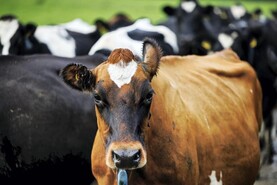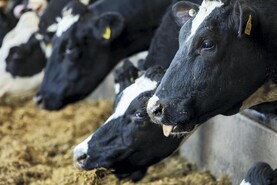When my wife and any number of her friends are gathered together for an evening, I have noticed that they tend to focus their conversation around this highly fascinating phenomenon called “the menopause”.
Apparently, (if they are to be believed) it involves night sweats, mood swings, irritable and unpredictable behaviour and sometimes a complete lack of energy towards the daily challenges of everyday life.
Therefore, I would like to publicly announce that I must be going through the menopause, because most of those traits are instantly recognisable in me.
I mention this because it was brought into sharp focus a couple of weeks ago, with a CAFRE Business Development Group (BDG) meeting on the cards, as well as a visit from a farm adviser to discuss last year’s benchmarking results.
In truth, I felt like something of a fraud, because I have, to some extent, lost interest in developing the farm in many new directions, and anyone trying to use the benchmarking as a lever to change old habits might as well go and talk to a field of grass.
Is it acceptable to admit that pure farming no longer excites me the way it used to?
Is it normal, after 45 years of farming to want as little change as possible?
Am I allowed to openly confess to having a strong desire (sometimes overwhelming) to cut back the workload with a view to taking a lot more time off?
Here’s an admission – by far the most enthusiastic I got in the last fortnight was when my brother-in-law phoned to say he had a day’s walking planned in the Mourne Mountains, and was I interested. Interested? I was squeaking with excitement.
Similar position
I wonder how many other farmers are in a similar position. I realise that anyone with young ones coming forward to farm are in a completely different situation, and I suspect that influx of youthful exuberance and ambition gives a lot of tiring farmers a renewed lease of enthusiasm.
In contrast, I have more interest in locating others like myself, with a view to setting up a discussion group of TOGs (tired old geezers). Joking apart, there may be ever-increasing numbers of farming people who, like me, are wanting to slow down just a little bit but aren’t sure how to get off the hamster wheel.
Margins
Perhaps the benchmarking results are a contributing factor also – healthy profits were shown in 2021 from both the dairy heifer rearing, as well as the sheep flock.
Gross margins of £132/head for sheep, and £368/head for the dairy-bred stock possibly allow complacency to set in, and maybe a return to low profits would see me regain some hunger and appetite for the job in hand (although sometimes you’ve got to be careful what you wish for).
Last year’s ewes finished up with a lambing percentage of 1.93 which obviously then is reflected in high output figures (£195/ewe)
Understanding the detail of benchmarking is important too. I have quoted gross margins, and not mentioned net profits for good reason.
In recent times, I have been building sheds and buying new machinery and equipment. This wreaks havoc with machinery and building depreciation figures, and a gross margin that may be inside the top 25% of benchmarking farms can suddenly drop back and show a very average net figure, when these overheads are considered. And last year’s ewes finished up with a lambing percentage of 1.93 which obviously then is reflected in high output figures (£195/ewe), but along with that comes the necessity of accepting a higher-than-normal amount of concentrate fed (77kg per ewe).
Overall
Taking one enterprise with the other, the overall balance of the farm isn’t far away, and best advice would probably be to carry on as before. It’s the other, far more important balance that still needs an awful lot of work. The balance between work and play has been out of kilter for too long.
Read more
Watch: big grass crops from a spattering of N
Watch: should I switch to milking cows?
When my wife and any number of her friends are gathered together for an evening, I have noticed that they tend to focus their conversation around this highly fascinating phenomenon called “the menopause”.
Apparently, (if they are to be believed) it involves night sweats, mood swings, irritable and unpredictable behaviour and sometimes a complete lack of energy towards the daily challenges of everyday life.
Therefore, I would like to publicly announce that I must be going through the menopause, because most of those traits are instantly recognisable in me.
I mention this because it was brought into sharp focus a couple of weeks ago, with a CAFRE Business Development Group (BDG) meeting on the cards, as well as a visit from a farm adviser to discuss last year’s benchmarking results.
In truth, I felt like something of a fraud, because I have, to some extent, lost interest in developing the farm in many new directions, and anyone trying to use the benchmarking as a lever to change old habits might as well go and talk to a field of grass.
Is it acceptable to admit that pure farming no longer excites me the way it used to?
Is it normal, after 45 years of farming to want as little change as possible?
Am I allowed to openly confess to having a strong desire (sometimes overwhelming) to cut back the workload with a view to taking a lot more time off?
Here’s an admission – by far the most enthusiastic I got in the last fortnight was when my brother-in-law phoned to say he had a day’s walking planned in the Mourne Mountains, and was I interested. Interested? I was squeaking with excitement.
Similar position
I wonder how many other farmers are in a similar position. I realise that anyone with young ones coming forward to farm are in a completely different situation, and I suspect that influx of youthful exuberance and ambition gives a lot of tiring farmers a renewed lease of enthusiasm.
In contrast, I have more interest in locating others like myself, with a view to setting up a discussion group of TOGs (tired old geezers). Joking apart, there may be ever-increasing numbers of farming people who, like me, are wanting to slow down just a little bit but aren’t sure how to get off the hamster wheel.
Margins
Perhaps the benchmarking results are a contributing factor also – healthy profits were shown in 2021 from both the dairy heifer rearing, as well as the sheep flock.
Gross margins of £132/head for sheep, and £368/head for the dairy-bred stock possibly allow complacency to set in, and maybe a return to low profits would see me regain some hunger and appetite for the job in hand (although sometimes you’ve got to be careful what you wish for).
Last year’s ewes finished up with a lambing percentage of 1.93 which obviously then is reflected in high output figures (£195/ewe)
Understanding the detail of benchmarking is important too. I have quoted gross margins, and not mentioned net profits for good reason.
In recent times, I have been building sheds and buying new machinery and equipment. This wreaks havoc with machinery and building depreciation figures, and a gross margin that may be inside the top 25% of benchmarking farms can suddenly drop back and show a very average net figure, when these overheads are considered. And last year’s ewes finished up with a lambing percentage of 1.93 which obviously then is reflected in high output figures (£195/ewe), but along with that comes the necessity of accepting a higher-than-normal amount of concentrate fed (77kg per ewe).
Overall
Taking one enterprise with the other, the overall balance of the farm isn’t far away, and best advice would probably be to carry on as before. It’s the other, far more important balance that still needs an awful lot of work. The balance between work and play has been out of kilter for too long.
Read more
Watch: big grass crops from a spattering of N
Watch: should I switch to milking cows?






 This is a subscriber-only article
This is a subscriber-only article










SHARING OPTIONS: